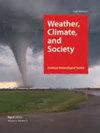Public attention during Hurricanes Florence and Michael
IF 1.9
4区 地球科学
Q3 ENVIRONMENTAL STUDIES
引用次数: 2
Abstract
In 2018, Hurricanes Florence and Michael affected the southeastern portion of the United States with widespread impacts in Florida, North and South Carolina, Georgia, and Virginia. The two storms were markedly different in terms of their meteorological history: Hurricane Florence made landfall as a Category 1 storm approximately two weeks after formation, while Hurricane Michael made landfall as an “unprecedented” Category 5 storm just three days after formation. The stark meteorological differences provided the opportunity to explore whether and to what extent public attention is influenced by storm severity. This study utilized both direct (i.e., tweet volume, search volume) and indirect (i.e., number of newspaper articles) measures to explore public attention at different scales. The results found that Hurricane Florence received more attention than Hurricane Michael, both regionally and nationally, across all three measures. The findings also underscore the importance of time for the process of attention-building, especially at the national-level. Taken together, the results suggest that storm severity, forecast lead-time, previous meteorological history, and population density intersect with one another to influence public attention in complex ways. The paper concludes with some opportunities for future research that may provide additional insights into the linkages between attention, perception, and decision-making.飓风佛罗伦萨和迈克尔期间的公众关注
2018年,飓风佛罗伦萨和迈克尔影响了美国东南部,对佛罗里达州、北卡罗来纳州和南卡罗来纳州、佐治亚州和弗吉尼亚州产生了广泛影响。这两场风暴在气象历史上有着明显的不同:飓风佛罗伦萨在形成大约两周后以一级风暴的形式登陆,而飓风迈克尔在形成仅三天后就以“前所未有的”五级风暴的形式登陆。明显的气象差异提供了探索公众注意力是否以及在多大程度上受到风暴严重程度的影响的机会。本研究采用直接(即推文量、搜索量)和间接(即报纸文章数)两种方法来探索不同尺度的公众关注。结果发现,无论是在地区还是在全国范围内,飓风佛罗伦萨都比飓风迈克尔受到了更多的关注。调查结果还强调了建立注意的过程需要时间,特别是在国家一级。综上所述,结果表明风暴的严重程度、预报提前期、以前的气象历史和人口密度相互交叉,以复杂的方式影响公众的注意力。这篇论文总结了一些未来研究的机会,这些研究可能会为注意力、感知和决策之间的联系提供更多的见解。
本文章由计算机程序翻译,如有差异,请以英文原文为准。
求助全文
约1分钟内获得全文
求助全文
来源期刊

Weather Climate and Society
METEOROLOGY & ATMOSPHERIC SCIENCES-
CiteScore
3.40
自引率
13.60%
发文量
95
审稿时长
>12 weeks
期刊介绍:
Weather, Climate, and Society (WCAS) publishes research that encompasses economics, policy analysis, political science, history, and institutional, social, and behavioral scholarship relating to weather and climate, including climate change. Contributions must include original social science research, evidence-based analysis, and relevance to the interactions of weather and climate with society.
 求助内容:
求助内容: 应助结果提醒方式:
应助结果提醒方式:


